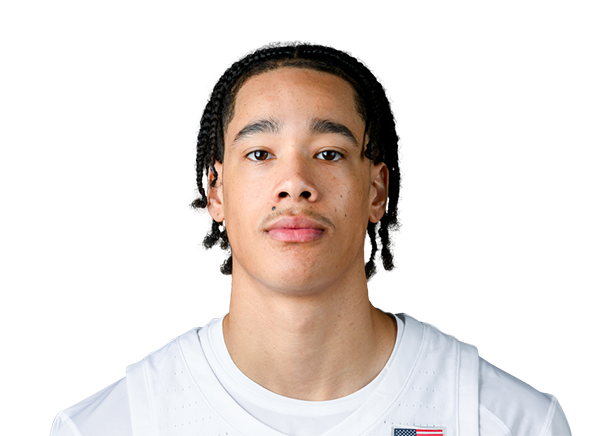Full Analysis
Offense
Nolan Traore’s offensive game is centered on rare burst, fluidity, and feel. His first step is arguably the most dangerous in the 2025 draft class, not a violent explosion, but a gliding, controlled burst that leaves defenders out of position before they can react. It’s not just raw speed; Traore has an intuitive grasp of timing and manipulation, knowing exactly when to shift gears, accelerate out of hesitations, or freeze defenders with his eyes before threading a pass.
At his best, Traore looks like a floor general in full control. He thrives in pick-and-roll situations, blending velocity with advanced pacing and vision. Whether slinging crosscourt skip passes, lofting touch lobs, or slipping live-dribble bounce passes to rollers, Traore displays real nuance as a playmaker. His ability to probe, pause, and strike creates consistent advantages, and he has already shown signs of becoming an elite pick-and-roll initiator. In transition, his speed and processing shine even more. He consistently makes smart decisions at full speed, hitting teammates in stride or turning on the jets himself to score in a blink. His 64.9% shooting on two-pointers in transition underscores how lethal he is with space.
Scoring-wise, Traore remains a work in progress. He has outstanding body control and creativity at the rim, able to contort and spin for acrobatic finishes. But he’s a below-the-rim player who struggles to finish through contact, and against NBA length, his already-low rim efficiency could take a further hit. The floater game, a staple of many smaller guards, is currently inefficient;he converts just 33.3% of floaters, and his limited elevation in traffic makes many of these looks even tougher.
The jumper is the swing skill. Traore has smooth pull-up mechanics in theory, but they break down in practice. His pull-up efficiency is low across the board, just 27.1% on pull-up twos and 24.1% on pull-up threes over two seasons. Too often he settles for off-balance, fading looks with poor footwork, especially out of the pick-and-roll. His catch-and-shoot numbers this year (39.1% on 46 attempts) offer some optimism, particularly since his form looks much cleaner when set and in rhythm. Still, across all situations, his 3-point percentage sits at 28.5%, and his career mark in France is 28.7%. While his 73.8% from the line suggests the touch may develop, the shot’s consistency and reliability remain an open question.
Decision-making is another area of concern. Traore sometimes locks into a predetermined read or forces plays that aren't there. His turnover rate hovered around 20% across both of his professional seasons, a reflection of the risk-taking and occasional carelessness in his game. Still, it’s important to note that he sees plays others miss. He’s not making the wrong reads so much as forcing the right ones into tight windows. With time and coaching, those turnovers could be cut down without neutering his creativity.
Defense
Traore’s defense is underdeveloped and inconsistent, though not devoid of upside. On the ball, his footwork and angles often betray him. He opens his hips too early, struggles to fight through screens, and rarely dictates terms to the offensive player. Opponents find it too easy to drive past him, and his strength deficits make him vulnerable to physical guards.
Off the ball, he shows better moments. His exceptional reflexes allow him to make impact plays even when out of position, jumping passing lanes or closing out late with surprising quickness. But too often, those flashes come after breakdowns of his own making. He’s prone to ball-watching, slow on rotations, and plays far more reactive than proactive. These habits won’t hold up at the NBA level unless corrected.
Still, his tools suggest there’s something to work with. He’s shifty and agile laterally, with enough height to guard other point guards and combo guards if he can strengthen his frame. His defensive value may ultimately hinge on whether he can transition from being a reactive athlete to a disciplined team defender. That transformation will take time and patience, and likely won’t occur in his rookie year, but it's not out of reach given his instincts and quick-twitch tools.
Looking Ahead
Nolan Traore is a bet on feel, speed, and long-term upside. Though his early-season struggles and shaky efficiency dragged his stock from top-five buzz into the back half of the first round, he remains one of the most intriguing development prospects in the class. It’s rare for a teenager to earn starting point guard duties in a professional league like LNB Pro A, let alone produce consistently in that role. Even amid his inconsistencies, Traore helped push Saint-Quentin to playoff contention and showed flashes of a lead initiator in the making.
The key to unlocking his ceiling lies in the jumper. If he becomes even an average pull-up shooter, everything else opens up as defenders will have to go over screens, which gives him the runway to leverage his speed, change gears, and punish help with surgical passing. If not, his game may stall in the half-court, especially against NBA drop coverage or switches that force him into tough, contested looks. His spot-up improvement offers a starting point, but he’ll need to overhaul his pull-up mechanics and shot selection to reach the next tier of NBA creators.
Defensively, he must build strength, improve screen navigation, and commit to more disciplined rotations. His tools aren’t elite, but they’re enough, if paired with consistent effort and reps, to become at least serviceable on that end. It won’t be his calling card, but it doesn’t have to be if his offense develops.
Traore needs the right context: a team willing to invest in him as a long-term project, give him real on-ball reps, and live with his mistakes. If boxed into an off-ball role too early, he risks losing the rhythm and creativity that make him special. For teams seeking a future lead guard, his passing, tempo control, and burst are compelling tools to mold. With patience and development, Traore still has a clear path to becoming a high-level NBA guard, even if the route there has been bumpier than expected.


